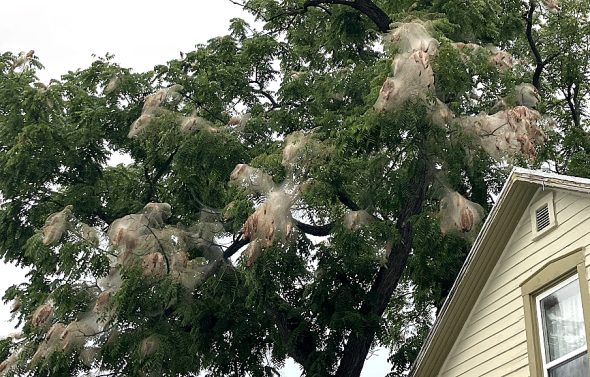
A crop of webworm silk nests in walnut trees along South Walnut St. as they appeared in the late summer of 2022. (Photo by Reilly Dixon)
Down to Earth | Fall webworms, friend or foe?
- Published: January 30, 2023
By Don Cipollini
There is a spectacle that occurs in summer each year around Yellow Springs that generates both amazement and concern among citizens and visitors of this town. No, it’s not Street Fair; it’s the return of fall webworms to their local perches.
Fall webworms (Hyphantria cunea) are the larvae of an inconspicuous white moth that make their appearance in trees and shrubs in late summer and fall. Webworms get misidentified as several things, including tent caterpillars, armyworms or bag worms, but each of those are common names for other species. While they are here each year, the abundance of this native herbivore varies from year to year, and the last three years have been big years for this insect.
After adults emerge from their cocoons and mate, females lay eggs on foliage of a wide variety of trees and shrubs — over 600 species known to date. The larvae that emerge are long-haired caterpillars that make communal silk nests at the ends of branches within which the larvae feed when they are young. Larvae are gregarious, participating in some interesting synchronous defensive behaviors, and must remain in a group until they are older to feed and develop normally.
They feed on foliage, and when their numbers are high, there can be dozens of nests in a single tree, and trees can become completely covered by webbing and entirely defoliated. This is quite striking when it happens, with 2021 a particularly notable year for it, and it generates lots of questions about the impact on the health of host trees.
Surprising to most, the impacts of webworms on large, healthy trees are minimal. This is in large part due to the timing of their damage, which typically occurs after trees have had three months or so of pest-free growth during which time they have been photosynthesizing normally and storing resources for the following year. In 2021, for example, some trees that were completely defoliated by mid-August by the webworms had fully re-leafed by a month later. Heavily attacked trees also leafed out normally in spring of 2022 by my observations. As proof, watch leaf development this spring in any of the larger black walnut trees around town. Black walnuts are a preferred host of webworms and are attacked to varying degrees each year. These trees are abundant along many streets in town, such as the aptly named Walnut Street, and along the bike trail and in Glen Helen Nature Preserve. Many were heavily attacked in 2022, as they were in 2021, and I predict that they will leaf out normally in 2023.
Impacts can be felt by smaller trees, however, in which case webs can be manually removed in backyard or orchard situations. However, pesticide treatment is neither feasible nor generally needed for most trees.
Another part of the spectacle of fall webworms is when they grow larger, become independent and stray increasingly farther from the web as they seek new hosts and identify a location to pupate and form a cocoon. During this time, larvae will wander over anything in their path, often appearing on trees, houses, sidewalks, lawns and cars. After about six weeks of stirring emotions, they pupate in a cocoon hidden in bark crevices and leaf litter on the ground, where they will overwinter waiting for it to start all over the following year. The fact that their population sizes vary from year to year has much to do with the buildup and subsequent release from predators and pathogens that help regulate their population sizes. After three big years, I predict that fall webworms will be a little less noticeable in 2023, as population sizes of the things that eat them have built up and will increasingly impact them.
Given that their feeding is not overly deleterious, can the presence of webworms be beneficial? Aside from a role in the recycling of nutrients between trees and the soil, webworms are a preferred food for cuckoos, which are among a handful of bird species that specialize on caterpillars with fuzzy bodies. As they eat webworms or other fuzzy caterpillars, their gut becomes lined with the indigestible hairs. But, rather than get upset, they shed their entire gut lining, grow it anew, and resume feeding on an abundant resource that is largely unpalatable to other species. Lots of fall webworms mean lots of baby cuckoos!
*Yellow Springs resident Don Cipollini, Ph.D., is director of environmental sciences and a professor of biological sciences at Wright State University.
The Yellow Springs News encourages respectful discussion of this article.
You must login to post a comment.
Don't have a login? Register for a free YSNews.com account.














No comments yet for this article.